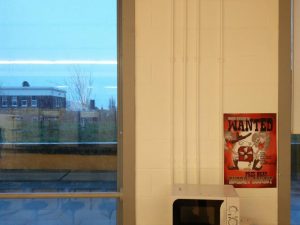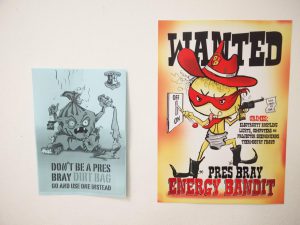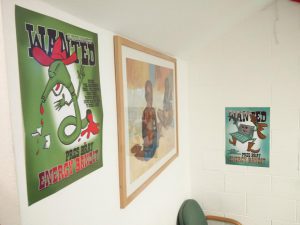Students from Presentation College Bray were involved in an Energy Saving Project to meet the challenges of the Green Schools Energy initiative and mark Catholic Schools Week, and its focus on environmental issues, as per Pope Francis’ encyclical Laudato Si.
Who are we?
Luca Pezillo O’Brien, Ciaran McKay, Jack Lawlor and art teacher Clifton Rooney
What we did

The school’s project showcased the artwork of students Luca Pezillo O’Brien, Ciaran McKay and Jack Lawlor around the school, in order to raise awareness about unnecessary energy usage, as well as a research project into whether the artwork has made a real difference to the school’s energy use. The project is an exemplar for the embodiment of the values underpinning a justice and value-based educational project
The school was in the process of applying for an Energy Green Flag from Green Schools, having received it’s first for recycling, the previous year. The art department had been planning an extra-curricular based project with this theme (energy usage) for the purposes of proactive cross-curricular engagement. At this point, the concept of respect, caring for the community and our home became an implicit theme underlying further explorations. You can listen to the lads discuss their project here.



The project was initiated by art teacher Clifton Rooney and flourished through the work of Ciaran, Luca and Jack. The student mix was interesting. It began with one TY student and one first year student. The mutual respect shown for each other was inspiring as they both worked to their strengths towards the tentative goals set for them. The pair pushed each other and learned from each other. It is quite interesting as a teacher to sit back and watch just how independent young people can be and how little direction they need when they buy in and then begin to form their own ends. In order for this to happen, the ends must be tentative. A predestined outcome is a sure way to stifle independent expansive thinking. It is however good to have some tentative plans in place as a starting point.
What was just as interesting was where the students recognised that they would benefit from divergent skills. The students chose to engage another TY student with a compliment skill set to expand the project. The self-reflection inherent in that action spoke volumes of their energetically developing ideas and the courage to look beyond themselves to realise those ideas was an act of great maturity.
How we did it
The process was as follows:
- Brainstorming (creating character designs from the initial ‘Energy Bandit’ ideas etc)
- Design and naming of characters and posters using a drawing tablet on a computer
- The idea of ‘sticker bombing’ was devised to create the awareness needed in order for the project to be successful, as well as posters and flyers for circulation
- On a Friday after school, we then ‘sticker bombed’ it, so students arriving in on Monday morning would be welcomed by all of the stickers sharing their particular message
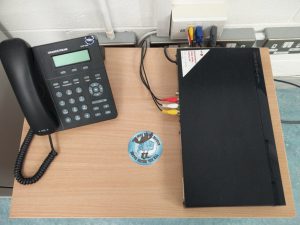
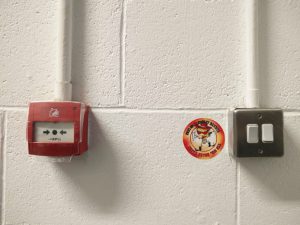
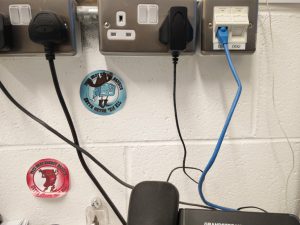
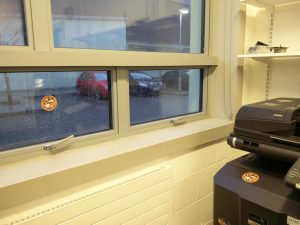
One activity/component of the project which was of value revolved around how we would communicate with our community. We generated something enormous in terms of its geographical and digital reach out of only 10 little drawings really. How did we do this?
- We analysed our school and its potential sites of energy waste/conservation. We used objects to represent these sites – a thermometer for heat, a fuel pump to represent plastics, an engine to represent use of cars, a telephone to represent energy waste through over-charging and app-over use etc.
- These sites/objects became characters. These characters then represented how we may waste/conserve energy in a specific context. We were then able to draw parallels between energy waste in school and in the home.

- We knew it was impossible to place large quantities of information at all the potential sites so we needed a system of visual cues or ‘aide memories’.
- Out of this need grew the development of the stickers. While the stickers could be placed anywhere in the school without causing interference, they gave very little information.
- Out of the need to further communicate around the specifics of energy waste grew the development of posters which of course could only be placed in areas of moving human traffic. While the posters expanded on the stickers in terms of information, they still failed to communicate the research that the students were passionate to disseminate.
- Out of this need, the students developed digital fliers which were shown on every big screen/white board in the school on period 1 every day for 10 days so that they could be used as a talking point for the beginning of the day between teachers and students and between students themselves. In this way, all 10 topics could be discussed with each member of the school community over a period of 10 days.
- Out of the need to forge parallels with the home environment, the students organised that the digital fliers would also be sent to every parent in the community during the 10 day period via the school app. This not only aimed to inform parents but provided a springboard for discussion around the issues in the home. It is of course the hope that parents and students alike might refer to each other as Pres Bray Energy Bandits if partaking in energy waste.
- Out of the need to explore more the consequences of our actions in a global context in relation specifically to energy, one of the students researched and crafted an online blog (published here on developmenteducation.ie) about this. He has presented it for publication in our yearbook which will be produced in the coming weeks.
- Out of the need to help others learn from these actions, we arrive here, at this case study, and while the steps discussed above were not as sequentially neat as have been described and overlap, under-lap, interlock and mesh with one another, there is a narrative.
- The narrative revolves around the continual drive to meet the needs/drive to communicate – what am I looking to communicate, why, how and to whom?
Did we succeed?
It is difficult to establish the actual quantifiable outcomes of the project (even though we took controlled meter readings during the campaign) as the campaign fits within a larger picture of energy awareness and conservation within the school spear-headed by Stuart Hannon, Green Schools Coordinator. The school has certainly shown quantifiable improvements in energy conservation.

While we began with no plan to measure impact, it became more of an interest and priority to the group as the work developed. As discussed above, the quantifiable outcomes are difficult to isolate from the many other efforts within the school to meet the same ends. I personally found fascinating the use of the character’s names by students. I have overheard names like ‘Frank The Tyrant Tap’ or ‘Tree Munching Jim’ on many occasions during student-to-student conversations. Furthermore, students began collecting the stickers, which I was not so sure about at first but the strap line they included ‘Gotta catch ‘em all’ – an obvious play on popular culture but also referring to the idea that students were encouraged to catch out the Energy Bandits – often teachers, led students to the conclusion that they were meant to collect them all! I have many times taken up a journal decorated with the full compliment of stickers or overheard conversations such as “have you got ‘Pete the Pickpocket Socket’ yet”.
UPDATE
Towards the end of the school year, Luca, Jack, Ciaran and Mr Rooney carried out a small piece of research to assess the overall impact of their project. A comparison was made between the time frame of the project and the exact same time period from the previous school year. There was an overall saving on the school’s energy bills of as much as 9%! Lets hope that the students in Pres Bray continue to round up those pesky Energy Bandits and catch ’em all, for good!
- Photo Credits: All Photos copyright Clifton Rooney 2017

